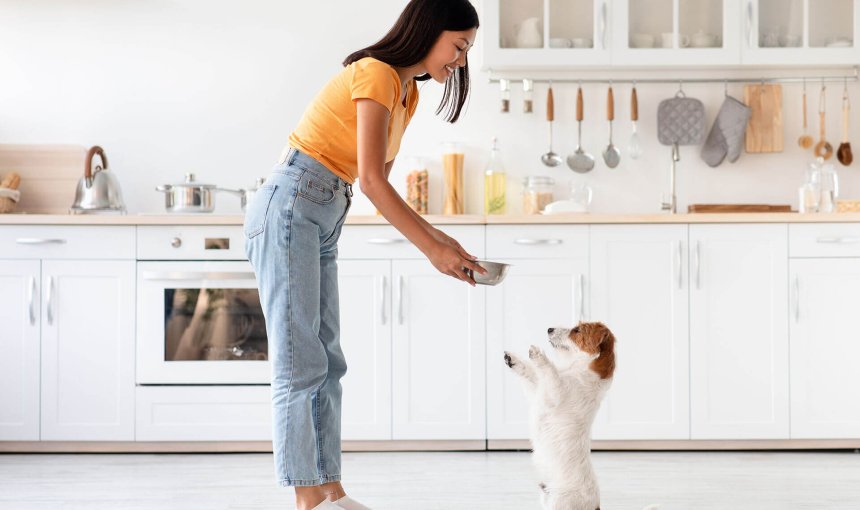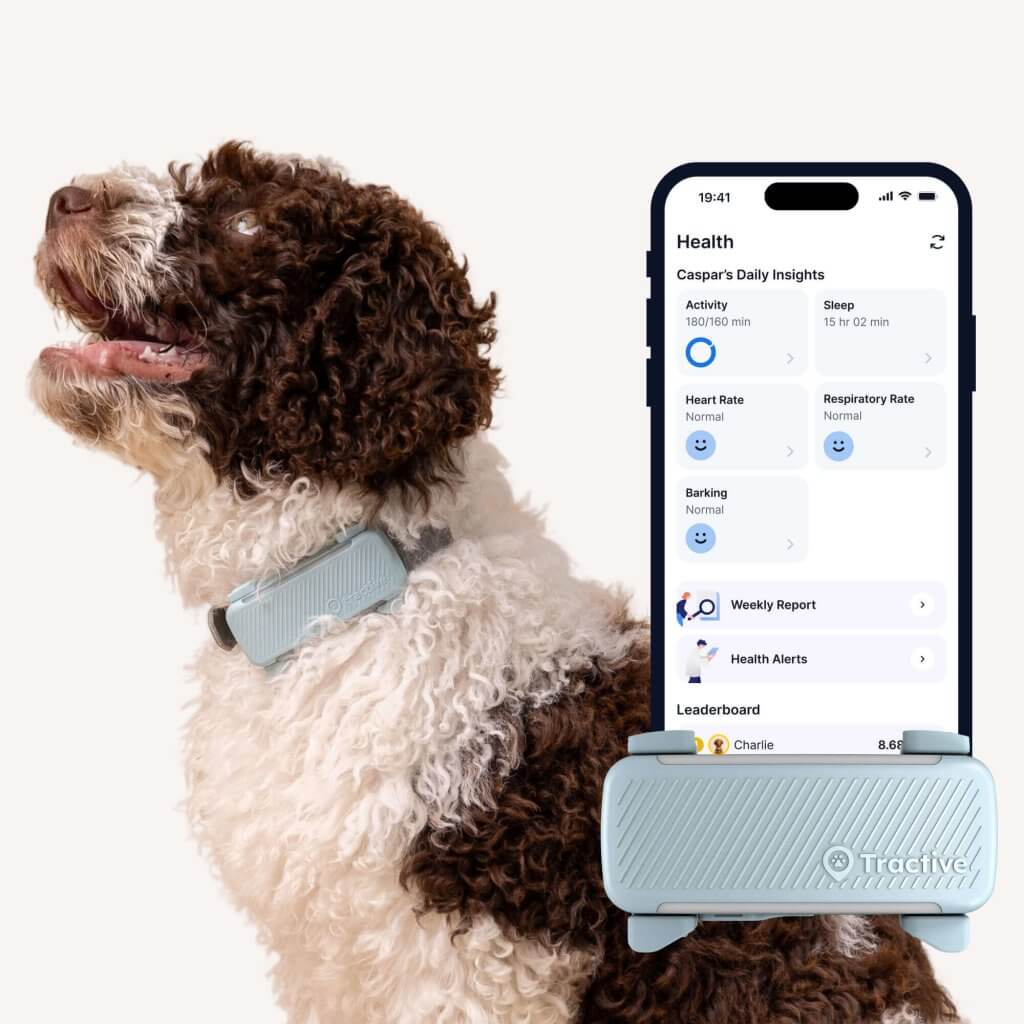Summer Dog Food: How To Keep Your Buddy Cool & Well-Fed
Not sure what to feed your dog on those hot summer days? Here are some of our summer nutrition tips for dogs, plus how to spot a potential health issue before it arises.

You wouldn’t be the first to wonder if your dog eats less in summer – and you’d be right! Here are a couple of safe summer dog food options for the warmer months, some tips on how to stay on top of their nutrition, and how a smart dog tracker with Health Monitoring can help you spot potential health issues early.
Key Takeaways
Dogs’ diets may change in summer; offer lighter, fresher meals with high water content like wet food, watermelon, or cucumber.
Make sure your dog can always access fresh, cool water. Consider adding multiple water bowls or freezing water for hydration.
It’s normal for dogs to eat less in hot weather due to decreased activity. However, drop by your vet if they stop eating completely.
A smart dog tracker with Health Monitoring can help you figure out the difference between a summer-induced dip in your dog’s energy and appetite – and an underlying health issue.

Always know your buddy is healthy & safe
Read moreDo dogs eat less in summer?
High temperatures generally tend to make your dog less active. They may feel like lying around to stay cool and avoid heat exhaustion. So they will need less calories, since they’re using less energy. Also, it’s easier to stay warm in summer than winter, so this is another reason why your dog needs less calories. Plus, sometimes they may just feel too hot to be interested in their food.
💡 A smart dog tracker with Health Monitoring can help you pick up on subtle health red flags – like a drop in your dog’s activity. So you can catch on to a change quicker and earlier and get them checked up at the vet before their health worsens.

Get health alerts for your dog
Our pups can’t always tell us if something’s wrong. But if their tracker detects unusual changes in their routine, you’ll get an alert, helping you catch potential issues early.
Summer nutrition tips for dogs
Consider serving up lighter, fresher meals in summer – just like us, dogs tend to eat less in warmer months. Add some wet food to your dog’s diet to up their water intake and stimulate their appetite. Your dog will find some relief from fresh, raw, cooling foods in their diet – like fresh fruit. Just make sure not to leave their dinner out for too long, since hot temperatures makes food go bad faster (and bacteria grow more quickly). Your dog could get an upset stomach eating old or spoiled food.
Make sure your dog has access to clean, fresh water at all times. They’ll need more water in summertime – probably more than how much they usually need. Give your dog water that water is cool or room temperature – not ice cold. Cold water can be a shock to a dog’s system in the heat of summer. Don’t forget to bring that water with you on a walk or trip and feed your dog foods that have a high water content, like watermelon or cucumber.
Change up mealtimes to the cooler times of day – early morning and night rather than a big meal in the middle of the day. Place your dog’s food in a cool or shady spot – indoors ideally.
Finally, try and avoid dry dog food during the summer. While it’s convenient, it may just end up “warming up” your dog from the inside instead.
✅ Cooling foods for dogs
- Meat & fish
Turkey, duck, duck eggs, rabbit, pork, white fish, ocean fish - Eggs & dairy
Eggs, cottage cheese, yogurt - Vegetables
Spinach, broccoli, turnip, cauliflower, celery, cucumber, cabbage, lettuce, swiss chard, brussel sprouts, green beans - Fruit
Strawberry, melon, cranberry, banana, mango, apple, pear, coconut - Herbs & greens
Dandelion, kelp, seaweed, spiruline, wheat grass, peppermint, chlorella, alfalfa sprouts, majoram - Mushrooms
Button mushrooms, - Grains
Buckwheat, barley, wild rice, millet - Other
Tofu, sesame and flaxseed oil
Keep in mind, the cooling benefits of these foods will be higher if they are fed raw or lightly cooked, as the cooking process can destroy certain properties of foods. However, not all foods can be served raw to dogs and some raw foods might cause an upset stomach – brussel sprouts should be cooked for example. Do further research or ask your vet before adding a new food to your dog’s diet. And always start out slow by giving your dog only a small amount of the new food.
❌ What foods should you avoid in summer for dogs?
- Avocado
Which contains persin, a fungicidal toxin that can cause vomiting and diarrhea in dogs. It’s best to keep them away from your furry friend. - Onions, garlic, and chives
These alliums contain compounds that can damage a dog’s red blood cells, leading to anemia. Symptoms can include weakness, lethargy, and pale gums. They are often found in summer dishes like salads, marinades, and grilled foods, so be mindful of ingredients. - Alcohol
Even small amounts of alcohol can be highly toxic to dogs. It can lead to vomiting, diarrhea, central nervous system depression, tremors, and even death. With more outdoor gatherings and drinks being consumed, make sure your dog can’t access any of these. - Stone fruits (Cherries, peaches, plums)
While the flesh of these fruits in moderation might not be harmful, the pits contain cyanide, which is toxic. The pits also pose a choking hazard and can cause intestinal obstruction. Always remove pits before offering any small pieces of these fruits. - Corn on the cob
The corn itself isn’t harmful, but the cob is a significant choking hazard and can cause a serious intestinal blockage that often requires surgery. If you’re enjoying corn on the cob, make sure your dog doesn’t get ahold of it. - High-fat and greasy foods
Summer barbecues often feature fatty meats, hot dogs, and other greasy foods. While tempting to share, these can lead to pancreatitis (inflammation of the pancreas), severe stomach upset, vomiting, and diarrhea in dogs.
Make sure to keep your dog well-hydrated
In summertime, not only can dogs get easily overheated – but they can also become dehydrated. You can prevent dehydration by providing your dog with unrestricted access to fresh, cool water. To encourage your dog to drink more on hot days, place more water bowls around the house and garden and refill the water as needed.
Some people fill a dog bowl or bucket and freeze it overnight. As it melts during the day, it provides a steady supply of refreshing, cold water. You can also freeze, or simply chill, water in the refrigerator in water bottles and add the melting or chilled water to your dog’s water periodically throughout the day. Adding ice cubes to your dog’s bowl may also be a good idea.
Read more: 10+ Tips On How To Keep Dogs Cool In Summer
Why is my dog not eating in summer?
Much like us, dogs’ appetites take a natural dip in summer and they prefer more cooling foods. But if your dog is outright refusing to eat, make sure to drop by your vet for a checkup. It could be a result of:
- Heat stress
When it’s hot, dogs expend more energy trying to regulate their body temperature, and their focus shifts from food to staying cool. They might feel sluggish and simply not have the same desire to eat. - Dehydration
If your dog isn’t drinking enough water, they might feel uncomfortable and less inclined to eat. Ensure they always have access to fresh, cool water, and consider adding a bit of water to their kibble to increase their fluid intake. - Stress
Summer often brings changes to routines – vacations, visitors, thunderstorms, fireworks, or even just a change in your daily schedule. These disruptions can cause stress in dogs, leading to a temporary loss of appetite. Try to maintain a consistent routine for your dog as much as possible to minimize anxiety. - Underlying health issues
Dental pain, gastrointestinal upset, parasites, or more serious conditions like heatstroke can all lead to a loss of appetite. If your dog’s lack of eating is accompanied by other symptoms like lethargy, vomiting, diarrhea, difficulty breathing, or changes in behavior, head to your vet immediately.
How to spot a potential health issue early in the summer months
It’s normal for your dog’s appetite and energy to both take a dip in summer – but it’s important to tell the difference between a regular dip and the early signs of a potential health issue. If your dog seems significantly less active than before or refuses to eat, it could signal something more serious. That’s where a smart dog tracker with Health Monitoring can step in.
Strapped to your dog’s collar, your trusty Tractive device comes with a built-in motion detector to help you figure out:
- How active your dog has been all day
From your dog’s active minutes, which also includes how many calories your dog has burned. So you can portion their food sizes accordingly and keep them at a healthy weight. - Your dog’s vital signs
Including their breathing rate and heart rate. Any change in these could signal potentially serious conditions, including heat stress and even heat stroke. - Any weird changes in your dog’s activity
Like if there’s a sudden, weird drop – outside of any usual summer dip. In these cases, you’ll get a Health Alert prompting you to get them over for a checkup at the vet.




